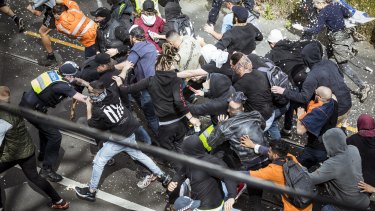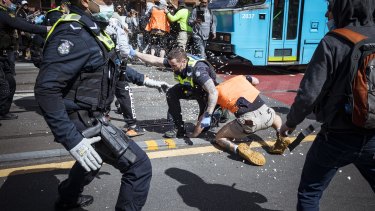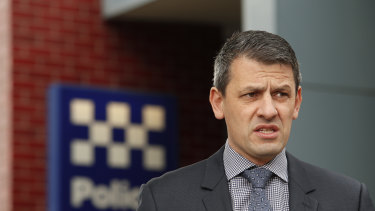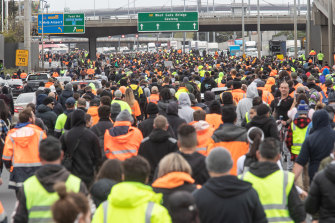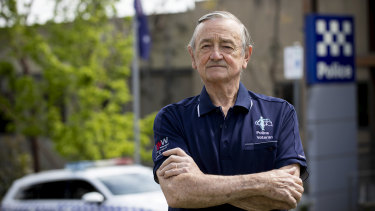‘Failed to protect them’: Tactical shortcomings, inadequate training raised in Kew protest review
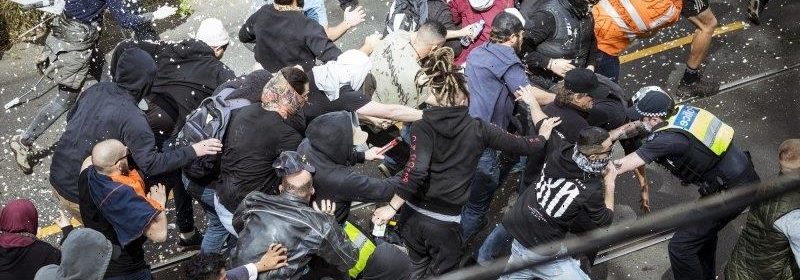
Police officers have expressed anger and dismay at what they say were major tactical and communications errors from police command that led to several injuries during a violent protest last month.
Their concerns were outlined in a scathing Police Association review that has recommended urgent changes to how the force handles demonstrations following the September 18 protest, which saw hundreds march through the streets of Richmond and Kew and clash violently with lines of general duties police officers.
Protesters clash with Victoria Police officers at an anti-lockdown rally in Richmond.Credit:Chris Hopkins
The review, finalised this week, found many members felt let down by Victoria Police and that the force failed to protect them at the violent demonstration, during which 10 officers were injured. The union said had heard from 1000 members about the incident, many of whom were angry or distressed.
Members told the Association they were ill-equipped and under prepared for what they faced, and that they were “baffled” by a decision to leave specially trained and equipped officers sitting idle just suburbs away from the unfolding chaos.
One of the recommendations was that specialist units such as the Public Order Response Team (PORT), Critical Incident Response Team and Special Operations Group be deployed to control protests. And where general duty members attend, they should be given government-funded PPE, helmets, face shields and knuckle protection.
“Members deployed in the CBD of Melbourne from multiple different units … expressed immense frustration, personal shame and anger that they were not able to help their colleagues when they needed it most,” the report said. “Those members who were deployed to the sector of the demonstration in Richmond were incredibly frustrated that they were not properly supported or backed-up.”
“The decision not to deploy PORT to the demonstration was seen by both members who were involved with the deployment and those who watched the events unfold via the news and social media, as inexplicably poor and baffling.”
Protesters clashed with police during a violent anti-lockdown rally in Melbourne’s inner east on September 18.Credit:Chris Hopkins
The review also uncovered what members said were tactical shortcomings during the protest including communication failures that meant emergency messages were unable to be transmitted because 1000 officers were using a single radio channel.
“Our members’ experiences show that decision-making failed to protect them, and ultimately led to preventable injury of more than ten police officers. Six of those members required hospitalisation.” the report said.
Other recommendations of the report included increased training, the use of separate radio channels for different operation zones and a review of public order management tactics.
The protest march on September 18 was originally planned for the city centre, but after Victoria Police moved to shut down public transport in and out of the CBD, the demonstration moved to the streets of Richmond and Kew.
There, about 700 protesters made their way to Barkers Road where some hurled projectiles and abuse at officers before surging through the police line and trampling members as tensions soared.
A thin line of police attempted to use capsicum spray and batons to keep the violence at bay before they were overrun in wild scenes captured on mobile phone footage.
About 2000 police had been deployed as part of the daily operation but only a small number were present at Barkers Road in Kew when the protest turned violent. The rest, including specialist units with shields, riot gear and non-lethal weapons, remained in the CBD and Richmond.
About 235 demonstrators were arrested.
The report went on to say that junior members used on the day had little or no public order training.
Some more senior members were also not properly trained or experienced which resulted in inconsistent messaging to the frontline, poor selection and adoption of tactics, and “chaos as the demonstration unfolded”, it said.
Victorian Police Association secretary Wayne Gatt.Credit:Paul Rovere
Police Association Secretary Wayne Gatt said while there was no suggestion Victoria Police deliberately set out to harm members, he said it would be remiss of the union not to raise members’ concerns.
“Our members made no suggestion that anyone intentionally or wilfully went to work that day to see anyone hurt, and indeed the blame for those injuries lies firmly at the feet of the protesters that caused them,” Mr Gatt said.
“But it would be remiss of us as the association that represents so many members, who expressed themselves so honestly, not to provide the candid feedback … for positive change to occur.”
The report follows growing frustration among rank and file members about the handling of anti-lockdown protests.
Last month, The Age reported the bungled September 18 deployment had caused serious friction between the Police Association and Victoria Police command, according to police sources not authorised to speak publicly.
Protesters walking towards Melbourne’s West Gate Bridge.Credit:Jason South
Only days later anti-vaccination and anti-government demonstrations saw protesters march onto the West Gate Bridge in a CBD rally where three officers were injured and police cars were also damaged.
Similar scenes confronted police at a rally to the Shrine of Remembrance on September 22. There, more than 200 were arrested and two police officers injured with non-lethal weapons including foam bullets, pepper balls and tear gas used.
Protest organisers have vowed to continue to march with another rally planned for this weekend and larger demonstration scheduled for late next month.
Former Victoria Police chief commissioner Kel Glare said footage from recent protests had shown a lack of command and control at times and believed the decision to close down public transport on September 18 backfired on police.
“In retrospect it was a mistake,” he said.
Former Victoria Police chief commissioner and Community Advocacy Alliance chairman Kel Glare.Credit:Arsineh Houspian
Mr Glare, who himself worked on the frontline during the Vietnam War protests in the 1970s, said covering protests was “never pleasant”. But as COVID-19 restrictions remain in place, he warned the state could expect to see a rising level of civil obedience.
”I think members have also become frustrated that they’re being used in this role, a role they see as political, and when politics interfere with police operations, there’s a problem,” Mr Glare said.
“I don’t like the Draconian restrictions, but given the law that does exist, police don’t get an option to decide which laws they will and won’t enforce.”
A Victoria Police spokeswoman said they were aware of the report and currently conducting their own internal investigation.
“Victoria Police continually reviews its operational response to all protests as per standard procedure. It would be premature to make any comment prior to knowing the outcome of the review,” they said.
The Morning Edition newsletter is our guide to the day’s most important and interesting stories, analysis and insights. Sign up here.
Most Viewed in National
From our partners
Source: Read Full Article

